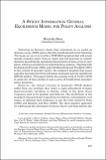Mostrar el registro sencillo del ítem
A sticky-information general equilibrium model for policy analysis
| dc.contributor.author | Reis, Ricardo | |
| dc.date.accessioned | 2019-11-01T00:04:30Z | |
| dc.date.available | 2019-11-01T00:04:30Z | |
| dc.date.issued | 2009 | |
| dc.identifier.isbn | 978-956-7421-32-9 | |
| dc.identifier.uri | https://hdl.handle.net/20.500.12580/3752 | |
| dc.description | Following on Keynes’s desire that economists be as useful as dentists, Lucas (1980) argues that this would amount to the following: “Our task, as I see it, is to write a FORTRAN program that will accept specific economic policy rules as ‘input’ and will generate as ‘output’ statistics describing the operating characteristics of time series we care about, which are predicted to result from these policies.” Starting with Kydland and Prescott (1982), and with Rotemberg and Woodford (1997) in the context of monetary policy, the computer program that Lucas asked for has taken the form of dynamic stochastic general equilibrium (DSGE) models. This paper follows the seminal work of Taylor (1979) in using one of these models to ask a series of hypothetical monetary policy questions. | |
| dc.format | ||
| dc.format.extent | Sección o Parte de un Documento | |
| dc.format.medium | p. 227-283 | |
| dc.language.iso | eng | |
| dc.publisher | Banco Central de Chile | |
| dc.relation.ispartof | Series on Central Banking, Analysis, and Economic Policies, no. 13 | |
| dc.rights | Attribution-NonCommercial-NoDerivs 3.0 Chile | * |
| dc.rights.uri | http://creativecommons.org/licenses/by-nc-nd/3.0/cl/ | * |
| dc.subject | POLÍTICA ECONÓMICA | es_ES |
| dc.subject | POLÍTICA MONETARIA | es_ES |
| dc.subject | MODELOS ESTOCÁSTICOS | es_ES |
| dc.title | A sticky-information general equilibrium model for policy analysis | |
| dc.type.doc | Artículo | |
| dc.file.name | BCCh-sbc-v13-p227_283 |


